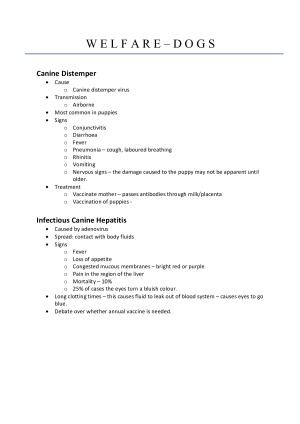Companion Animal Biology - Detailed H1 notes
Subject notes for UniMelb DASC20011
Description
These notes contain information from the entire semester. List of topics included: - Welfare of animals - History of dogs and humans - Behaviour problems; horses, cats, dogs - Causes of behaviour problems - Obesity in dogs - Animal Breeding - Nature vs nurture – animal outcome - Nature vs. Nurture – wild vs companion animals - Role of genetics - Traits influenced by genes - Changing the genome – animals - Sex linked inheritance - Epistasis - Recessive epistasis - Pleiotropy - Horse welfare - Tetanus - Strangles - Equine Herpes Virus Type 1 - Hendra Virus - Salmonellosis - Colic - Strongyle lifecycle - Strongyle damage - Roundworm - Pinworm - Tapeworm - Bot Fly Lifecycle - Worm prevention - Teeth care - Ringworm - Dermatophilus - Lice - Staph Boils - Warts - Sarcoid - Melanosarcoma - Toxic plants - Dog welfare - Canine Distemper - Infectious Canine Hepatitis - Canine parvovirus - Bordetellosis – Kennel cough - Roundworm - Hookworm - Whipworm - Tapeworms - Heart worms - Fleas - Teeth care - Checking the skin - Genetics and the health of dogs - Cat welfare - Feline enteritis - Cat flu - Feline immunodeficiency Virus – cat AIDS - Toxoplasmosis - Ringworm - Chronic kidney disease - Keeping your cat healthy -Other animal welfare - Rabbits – diseases - Psittacosis in birds - Animal perception - Visual acuity - Dogs – sight - Dogs – colour blindness - Dogs – hearing - Dogs – hearing - Dogs – smell – olfaction - Anatomy of the dogs’ nose - Dogs Olfactory - Sniffing and panting - Scent storage – dogs - Vomeronasal organ - Other roles of the Vomeronasal organ - What can dogs smell? - What do we use dogs for? - Cats - Cats – sight - Cats – whiskers - Horses – vision - Horses – hearing - Horses – smell - Flehmen – horses - Horses – touch - Birds – vision - Birds of prey – vision - Birds – range of vision - UV sight birds – function - Bird research – UV light - Birds –hearing - Nutrition - Companion animal vs Farm animal nutrition - Composition of food - Dry Matter (DM) - Energy - Protein - Order Carnivora - Difference between cats and dogs - teeth - Difference between cats and dogs – Digestive tract - Protein need - Cat nutrition: - Carbohydrates – cats - Protein: Essential amino acids – cats - Protein: Taurine requirement – cats - Vitamin A - Hypertoxicity - Fatty acids – cats - Senior cats diet - Effects of amino acid deficiencies - Difference between Cat and dog nutrition - Surface area: volume ratio effect on energy - Basal Metabolic rate - Standard metabolic rate - Metabolism vs temperature - Thermo-neutral zone - Feed level – and effects of temperature - Feed level and temperature - Dog nutrition - Essential amino acids – dogs - Pet Food information - Calculating energy from pet food - Drivers of choice – pet food - Small mammal orders - Difference between the two orders - Rabbit – digestion - Coprophagy vs Caecotrophy - Coprophagy - Rabbit – energy - Rabbit – Fibre - Rabbit – Lipids - Rabbit – Protein - Rabbit – Minerals - Rabbit – Vitamins - Guinea Pigs – nutrition - Guinea Pigs – Vitamin C deficiency - Guinea Pigs – Metastatic Calcification - Herbivorous Reptiles - Desert Tortoise – Digestive body anatomy - Desert Tortoise – how do they survive the water limitations? - Carnivorous reptiles – tongue action - Swallowing – reptiles - Nutritional Deficiencies - Calcium-Phosphorus imbalance - Avitaminosis A - Avitaminosis B - Avitaminosis D Behaviour and training - How do animals learn? - Instinct learning - Latent/exploratory learning - Classic conditioning - Operant conditioning - Clicker training - Shaping - Positive and negative reinforcement - Motivation - Types of Motivation/reward - Rewarding reinforcing patterns - Breed specific training and reward - Reward vs motivation - What motivates dogs? - Engagement training - Using rewards correctly - Phasing out rewards Backyard dogs - Dogs as an industry - Why are dogs good for us? - Are we good for dogs? - The welfare of pet dogs - Dog shelters - Human canine relationship - Responses of adult dogs to companionship and social separation - Socialisation with humans - Effect of early human contact on the attraction to handler at 16 weeks of age - Why is the human-canine bond important? - Housing - The backyard - Social and spatial restriction – issues - Appropriate feeding – obesity - Appropriate feeding – anorexia - Deficiencies and toxicity - Health – dogs - Owners need to look for - Pain - Behavioural indicators of pain - How to achieve Positive emotional states for dogs - Conclusions Aquatic pets - Environment types - Types of fish - Factors to consider for an Aquarium - Stocking density - Gaseous exchange - Heating and lighting - 3 types Filtration - Biological filtration - Enrichments - Chemical composition
UniMelb
Semester 1, 2019
60 pages
10,873 words
$39.00
25
Campus
UniMelb, Parkville
Member since
February 2018
